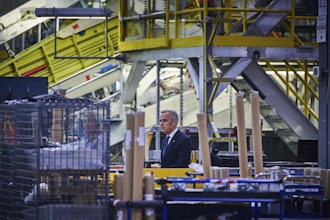Economic activity in the manufacturing sector expanded in December, and the overall economy grew for the 116th consecutive month, say the nation’s supply executives in the latest Manufacturing ISM Report On Business .
The report was issued this month by Timothy R. Fiore, CPSM, C.P.M., Chair of the Institute for Supply Management (ISM) Manufacturing Business Survey Committee: “The December PMI registered 54.1 percent, a decrease of 5.2 percentage points from the November reading of 59.3 percent. The New Orders Index registered 51.1 percent, a decrease of 11 percentage points from the November reading of 62.1 percent. The Production Index registered 54.3 percent, 6.3-percentage point decrease compared to the November reading of 60.6 percent. The Employment Index registered 56.2 percent, a decrease of 2.2 percentage points from the November reading of 58.4 percent. The Supplier Deliveries Index registered 57.5 percent, a 5-percentage point decrease from the November reading of 62.5 percent. The Inventories Index registered 51.2 percent, a decrease of 1.7 percentage points from the November reading of 52.9 percent. The Prices Index registered 54.9 percent, a 5.8-percentage point decrease from the November reading of 60.7 percent, indicating higher raw materials prices for the 34th consecutive month.
“Comments from the panel reflect continued expanding business strength, but at much lower levels. Demand softened, with the New Orders Index retreating to recent low levels, the Customers’ Inventories Index remaining too low — a positive heading into the first quarter of 2019 — and the Backlog of Orders declining to a zero-expansion level. Consumption continued to strengthen, with production and employment still expanding, but at much lower levels compared to prior periods. Inputs — expressed as supplier deliveries, inventories and imports — softened as well, with suppliers improving delivery performance, and inventories and imports declining.
Exports continue to expand, but at low levels consistent with November. Price increases relaxed to levels not seen since June 2017, when the index registered 53 percent. The manufacturing community continues to expand, but at much lower levels and at a sharp decline from November,” says Fiore.
Of the 18 manufacturing industries, 11 reported growth in December, in the following order: Textile Mills; Apparel, Leather & Allied Products; Machinery; Transportation Equipment; Computer & Electronic Products; Wood Products; Chemical Products; Food, Beverage & Tobacco Products; Miscellaneous Manufacturing; Electrical Equipment, Appliances & Components; and Primary Metals.
The six industries reporting contraction in December — in the following order — are: Printing & Related Support Activities; Fabricated Metal Products; Nonmetallic Mineral Products; Petroleum & Coal Products; Paper Products; and Plastics & Rubber Products.
What Respondents are Saying
- “Growth appears to have stopped. Resources still focused on re-sourcing for U.S. tariff mitigation out of China.” (Computer & Electronic Products)
- “Brexit has become a problem due to labeling changes.” (Chemical Products)
- “Customer demand continues to decrease [due to] concerns about the economy and tariffs.” (Transportation Equipment)
- “Starting to see more and more inflationary increases for raw materials. Also, suppliers [are] forcing price increases due to tariffs.” (Food, Beverage & Tobacco Products)
- “The ongoing open issues with tariffs between U.S. and China are causing longer-term concerns about costs and sourcing strategies for our manufacturing operations. We were anticipating more clarity [regarding] tariffs at the end of 2018.” (Machinery)
- “Business is steady, but pace of incoming orders are slowing.” (Furniture & Related Products)
- “Business is robust for certain sectors [aerospace] and flat to downward for others [energy]. Tariffs continue to impact business direction and profit.” (Miscellaneous Manufacturing)
- “Caution seems to be the outlook. Are we in a correction, or is the market getting ready to slow over time?” (Fabricated Metal Products)
- “No major change in business operations towards the end of 2018; however, we are carefully monitoring oil prices and outside influence from market conditions to better understand our 2019 outlook and capital plans.” (Petroleum & Coal Products)
- “Customers are hedge buying in December as a result of announced price increases starting in January.” (Textile Mills)
Manufacturing at a Glance — December 2018
| Index | Series Index Dec | Series Index Nov | Percentage Point Change | Direction | Rate of Change | Trend* (Months) |
|---|---|---|---|---|---|---|
| PMI® | 54.1 | 59.3 | -5.2 | Growing | Slower | 28 |
| New Orders | 51.1 | 62.1 | -11.0 | Growing | Slower | 36 |
| Production | 54.3 | 60.6 | -6.3 | Growing | Slower | 28 |
| Employment | 56.2 | 58.4 | -2.2 | Growing | Slower | 27 |
| Supplier Deliveries | 57.5 | 62.5 | -5.0 | Slowing | Slower | 27 |
| Inventories | 51.2 | 52.9 | -1.7 | Growing | Slower | 12 |
| Customers' Inventories | 41.7 | 41.5 | +0.2 | Too Low | Slower | 27 |
| Prices | 54.9 | 60.7 | -5.8 | Increasing | Slower | 34 |
| Backlog of Orders | 50.0 | 56.4 | -6.4 | Unchanged | Slower | 1 |
| New Export Orders | 52.8 | 52.2 | +0.6 | Growing | Faster | 34 |
| Imports | 52.7 | 53.6 | -0.9 | Growing | Slower | 23 |
| OVERALL ECONOMY | Growing | Slower | 116 | |||
| Manufacturing Sector | Growing | Slower | 28 | |||
Manufacturing ISM Report On Business data is seasonally adjusted for the New Orders, Production, Employment and Supplier Deliveries Indexes.
*Number of months moving in current direction.






















